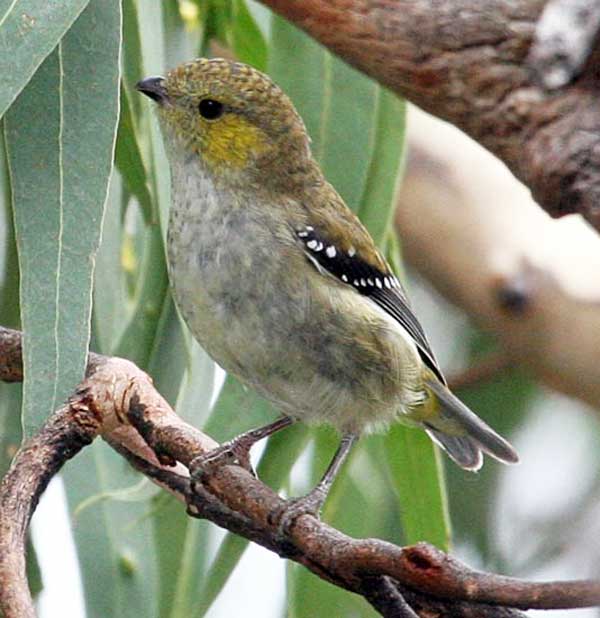
Pardalotus quadragintus (*)
Superregnum: Eukaryota
Cladus: Unikonta
Cladus: Opisthokonta
Cladus: Holozoa
Regnum: Animalia
Subregnum: Eumetazoa
Cladus: Bilateria
Cladus: Nephrozoa
Superphylum: Deuterostomia
Phylum: Chordata
Subphylum: Vertebrata
Infraphylum: Gnathostomata
Megaclassis: Osteichthyes
Cladus: Sarcopterygii
Cladus: Rhipidistia
Cladus: Tetrapodomorpha
Cladus: Eotetrapodiformes
Cladus: Elpistostegalia
Superclassis: Tetrapoda
Cladus: Reptiliomorpha
Cladus: Amniota
Classis: Reptilia
Cladus: Eureptilia
Cladus: Romeriida
Subclassis: Diapsida
Cladus: Sauria
Infraclassis: Archosauromorpha
Cladus: Crurotarsi
Divisio: Archosauria
Cladus: Avemetatarsalia
Cladus: Ornithodira
Subtaxon: Dinosauromorpha
Cladus: Dinosauriformes
Cladus: Dracohors
Cladus: Dinosauria
Cladus: Saurischia
Cladus: Eusaurischia
Subordo: Theropoda
Cladus: Neotheropoda
Cladus: Averostra
Cladus: Tetanurae
Cladus: Avetheropoda
Cladus: Coelurosauria
Cladus: Tyrannoraptora
Cladus: Maniraptoromorpha
Cladus: Maniraptoriformes
Cladus: Maniraptora
Cladus: Pennaraptora
Cladus: Paraves
Cladus: Eumaniraptora
Cladus: Avialae
Infraclassis: Aves
Cladus: Avebrevicauda
Cladus: Pygostylia
Cladus: Ornithothoraces
Cladus: Ornithuromorpha
Cladus: Carinatae
Parvclassis: Neornithes
Cohors: Neognathae
Cladus: Neoaves
Cladus: Telluraves
Cladus: Australaves
Ordo: Passeriformes
Subordo: Passeri
Infraordo: Corvida
Superfamilia: Meliphagoidea
Familia: Pardalotidae
Genus: Pardalotus
Species: Pardalotus quadragintus
Name
Pardalotus quadragintus Gould, 1838
References
A synopsis of the birds of Australia, and the adjacent islands. pt4, pl.7 BHL, fig.1,text BHL.
IUCN: Pardalotus quadragintus (Endangered)
Vernacular names
English: Forty-spotted pardalote
فارسی: خالسفید چهلخال
suomi: Tasmanianhelmikäs
français: Pardalote de Tasmanie
magyar: Tasmaniai gyémántmadár
Nederlands: Tasmaanse diamantvogel
Diné bizaad: Nahatʼeʼiitsoh Bikéyahdę́ę́ʼ tsídii daachʼį́dí yistłʼinígíí
پنجابی: تسمانی تیندوہ چڑی
русский: Тасманийская радужная птица
svenska: tasmanpardalot
українська: Діамантниця тасманійська
The forty-spotted pardalote (Pardalotus quadragintus) is one of Australia's rarest birds and by far the rarest pardalote, being confined to a few colonies in the south-east corner of Tasmania, mainly on Maria Island and Bruny Island.
Description
A small, energetic passerine about 9 to 10 cm (3.5 to 4 in) long, the forty-spot is similar to the much commoner spotted pardalote (Pardalotus punctatus), but has a dull greenish-brown back and head, compared to the more colourful plumage of the latter, with which it shares its range, and there is no brow line. The rump is olive, the under-tail dull yellow. The chest is white with light yellow tints. The wings are black with white tips, appearing as many (closer to 60 than 40) discrete dots when the wings are folded. There is no seasonal variation in plumage; juveniles are slightly less colourful than the adults.[citation needed]
Distribution and habitat
The forty-spotted pardalote is as of September 2021 found reliably only in a few isolated colonies on south-eastern Tasmania, most notably on Maria Island and Bruny Island. These two islands contain 99% of the species' population; there are a few colonies scattered across mainland Tasmania, and there may be a few left on Flinders Island.[2] In 2009 there were 450 individuals on Bruny Island and 974 on Maria Island. A 2009 survey counted 1,486 birds at 54 of the 102 colonies surveyed; this compares with 3,840 individuals counted in 121 colonies in 1991 to 1997 – a loss of 47% of colonies.[3]
The birds are found almost exclusively in dry eucalypt forests with high concentration of the Eucalyptus viminalis (white gum), where it forages almost exclusively. This species provides around 80% of the nestlings' diet.[2][3]
Conservation
In the 17 years prior to 2010/2011, there had been a decrease of up to 60% in overall population. It is listed by the IUCN as endangered, because of its very small range, its highly fragmented distribution and its very small breeding area.[3]
Threats include land clearing for sheep farming, low rainfall linked to climate change; bushfires; competitors such as noisy miners and striated pardalotes; predators such as the (introduced) laughing kookaburras; and the native parasitic fly Passeromyia longicornis.[3]
Behaviour
Forty-spots form pairs and are territorial during the breeding season, but may form small flocks during the winter. They are insect hunters and forage methodically for small insects in the canopy. They nest in tree hollows and occasionally in ground burrows.[citation needed]
References
BirdLife International (2022). "Pardalotus quadragintus". IUCN Red List of Threatened Species. 2022: e.T22704493A213392735. doi:10.2305/IUCN.UK.2022-1.RLTS.T22704493A213392735.en. Retrieved 7 February 2023.
Alvaro, Alexandra (17 September 2021). "Tasmanian student Erin Bok's mission to save the rare forty-spotted pardalote bird". ABC News. Australian Broadcasting Corporation. Retrieved 18 September 2021.
"Forty-spotted Pardalote Pardalotus quadragintus: Text zone". Birdlife International: Data Zone. Retrieved 27 September 2021.
Retrieved from "http://en.wikipedia.org/"
All text is available under the terms of the GNU Free Documentation License

